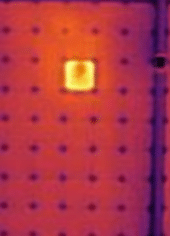🔥 Hot danger on the roof 🔥
It sounds paradoxical: heat can become a weak point precisely where solar energy is collected.
We are talking about so-called hotspots – areas within a PV module in which individual cells become very hot.
What begins inconspicuously can massively impair the performance of entire systems.
Hotspots are among the most common and most dangerous faults in photovoltaic systems.
But how do they occur and how can they be recognised at an early stage?

🔍 How do hotspots occur?
A hotspot occurs when one or more solar cells restrict the flow of current within a PV module and instead act as a resistor or load.
As a result, the affected area can become very hot – with temperatures of over 100 °C.
This overheating can not only lead to a loss of power, but can also cause serious damage and, in the worst case, pose a fire hazard.
What are the consequences of hotspots?
🔥 Yield losses – The energy yield of the entire module or string can drop.
⚠️ Material damage – The high temperatures can damage the module.
🚨 Fire hazard – The risk of fire increases if overheating persists.
Typical causes of hotspots
- Shading – Localised, partial shading caused by leaves, dirt, bird droppings or objects can cause this fault pattern.
- Solar cell defects – Mechanical stress or material defects can damage the solar cells installed in the module to such an extent that a hotspot occurs.
- Missing or open bypass diodes – Without functioning bypass diodes, the current cannot bypass faulty or shaded cells. Without the protective function of the bypass diodes, a hotspot occurs.
- Material fatigue or production errors – Ageing processes or poor manufacturing quality favour defects that can result in hotspots.
📷 How do you recognise hotspots using drone thermography?
Hotspots are not visible to the naked eye – but thermography makes them visible at an early stage, even before critical problems arise.
✅ Elevated temperatures – hotspots appear on a PV module as significantly warmer areas. Depending on the temperature difference, they can be categorised into different degrees of severity.
✅ Multi-hotspots – If there are several defective cells within a module, a pattern of several hotspots can form.
📢 More interesting Insights?
🔗 Subscribe to the Photovoltaik Vision WhatsApp channel & newsletter!
Author and expert: Jan Wannenwetsch